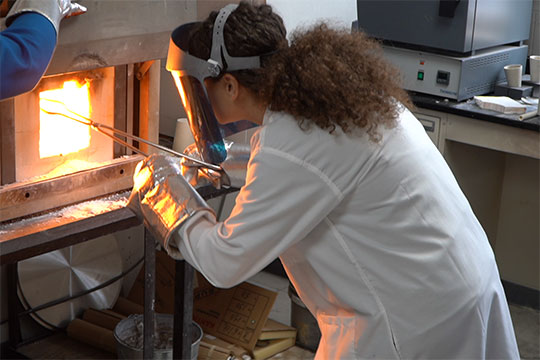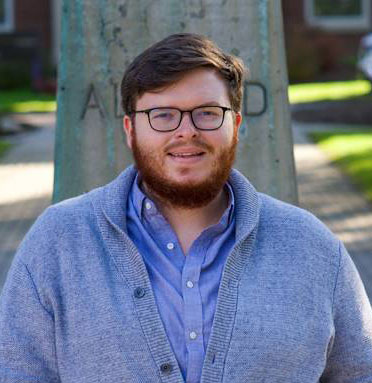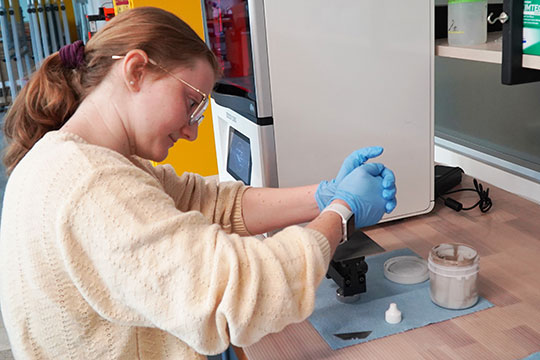Summer Research Institute offers unique learning opportunities for Alfred University undergraduates

Under a new program offered at Alfred University, several undergraduate engineering students spent the summer on campus, immersed in research projects guided by faculty from the Inamori School of Engineering.
The Summer Research Institute, sponsored by the Center for Advanced Ceramic Technology (CACT) at Alfred University, the New York State Foundation for Science, Technology, and Innovation (NYSTAR), Corning Inc., Owens-Corning, and Washington Mills, was held from May 30 through July 28. Approximately 30 undergraduate students—majoring in glass science engineering, ceramic engineering, biomaterials engineering, and materials science and engineering—performed research on projects supervised by 11 faculty.
Students worked 40 hours per week throughout the summer, were paid an hourly wage, were provided with free housing, and had a variety of professional development activities including tours of local companies. The program culminated with a poster contest, with cash prizes, outlining the various research projects. This unique experience allowed students to participate in research settings normally reserved for graduate students.
“Alfred is one of a very few places in the country that has an emphasis on undergraduate research and hands-on experiences,” said Collin Wilkinson, professor of glass science who supervised eight undergraduates in their summer research work. “Undergraduate students take more time compared to graduate students. You have them for three months (a semester) and they’re gone. It’s difficult to provide those one-on-one experiences.”
That’s not the case at Alfred, Wilkinson noted, where due to small class sizes, students have more opportunities to interact with faculty in a research environment, both during the academic year and in a program like the Summer Research Institute. “Normally, you can’t have every undergrad involved in a lab setting. But at a small school like Alfred, you have more potential for those opportunities. Students have a chance to grow while learning in the lab,” he said.

“Normally, you can’t have every undergrad involved in a lab setting. But at a small school like Alfred, you have more potential for those opportunities. Students have a chance to grow while learning in the lab.”
Collin Wilkinson, professor, glass science engineering
Gabrielle Gaustad ’04, dean of the Inamori School of Engineering, hopes to see the program grow in future years to provide even more students the opportunity to pursue their research interests.
“The fields of ceramics, glass, and materials science are constantly changing how we interact with the world around us. This program gives students an opportunity, very early in their college careers, to discover how these materials can impact our lives,” Gaustad commented. “Students present new and exciting concepts that may lead to future research as well as new solutions to some very complex challenges. It’s my expectation that we’ll see more students involved in this summer program in future years, pursuing research in topics that are not only important to them but to society as a whole.”
Vasilii Maksimov, a junior from Moscow, Russia, majoring in glass science engineering and physics, with minors in computer science and mathematics, worked on a research project that studied ways to decrease the amount of environmentally-harmful carbon dioxide created during the production of glass. “That’s a huge issue. We need to decarbonize the glass manufacturing process,” Maksimov said.
His research examined how melting glass with hydrogen combustion, which contains no greenhouse gases, affects the properties of glass, namely its durability and toughness.
“I’m simulating fractures in different types of glass and seeing how the concentration of hydrogen affects the toughness of the glass. It will contribute to a theoretical model that helps us understand hydrogen’s impact on the behavior of glass,” explained Maksimov, who is being advised in his research by Wilkinson. “Theoretically, this could produce guidelines on whether to use hydrogen in the glass melting process.”
Elene Taniashvili, a sophomore glass science engineering major from Tbilisi, Georgia, conducted research aimed at developing fertilizer made from waste glass products. “We’re trying to make a fertilizer that is more effective than traditional fertilizer and acts as a better silicon nutrient provider than rock dust,” she said.
Taniashvili explained that glass contains an element of silicon materials that is beneficial to plant growth. Her research, advised by William LaCourse, emeritus professor of glass glass and current research faculty member, modifies glass waste from a powdered form into a foam material that can hold more water and come in contact with a greater soil surface area than powder. The foaming process is done using water glass—a compound containing sodium oxide and silica—which avoids carbon dioxide emissions.
A key to the development of an effective fertilizer made from waste glass is the removal of sodium, which is detrimental to plant growth. Taniashvili said this can be achieved by a process called glass leaching, or ion exchange. Alexander Johnsson, a junior ceramic engineering and art and design major from South Windsor, CT, who is also working on the project, explained that the ion exchange process uses water to remove sodium, which is high in alkalinity, and replaces it with potassium, which is good for plant growth.
Jane Heffernan, a sophomore ceramic engineering major from Eden, NY, worked on a project studying ways to 3D print using silicon carbide. The research compared using digital light processing with traditional three-dimensional printing to determine if the former can produce ceramic materials with the same properties as the latter.
The project is part of the master’s thesis project of graduate student Anthony Brandl, whom Heffernan is assisting. Brandl is advised by Junjun Ding, professor of materials science and engineering. The research is being conducted as part of a partnership with the U.S. Army Research Laboratory, in which Alfred University received a $13.5 million five-year contract from the Army to research the forming and characterization of ultra-high temperature ceramic (UHTC) materials.

Heffernan’s research seeks to determine if materials printed using digital light processing are stronger than those printed in the traditional manner. “We’re most concerned with the process and results to determine properties” and how the materials hold up under extreme conditions, she explained. “3D printing utilizing photopolymerization is a much higher resolution. Using photopolymerization is still pretty new. We want to know how you can take it from the lab and use in industry.”
Research conducted by Wyatt Kiff, a senior glass science engineering major from Sidney, NY, is his senior thesis project. His work involves creating atomistic simulations to computationally analyze glass physics for applications in solid-state electrochemical electrolytes. Kiff, with Wilkinson as his advisor, worked on the project during his junior year and continued his research into the summer.
Beatrice Crespo, sophomore glass science engineering/art and design major from Tacoma Park, MD, researched the feasibility, from a technical and economic standpoint, of recycling photo-voltaic components in solar panels.
The recycling process, Crespo explained, involves delamination of the solar panels, which is required before the panels can be re-used. Her research, under the advisement of Wilkinson and Gabrielle Gaustad ’04, dean of the Inamori School of Engineering, studied both thermal delamination—which uses heat to soften and remove the laminate—and chemical solvent delamination.
VIDEO…2023 Summer Research Institute
Wilkinson said exposing undergraduates to research opens up a host of opportunities which are often not available in larger schools. This includes hands-on experience with equipment normally reserved for graduate students and learning in a research lab setting early in their college careers.
“At a larger school, you might have 300 graduate students sharing equipment; (those resources) are set aside for graduate students. Because we’re a small school, with small class sizes, we don’t have those limitations,” Wilkinson said. “It’s why we can have a program like this. Students have been trained on our equipment, in many cases, starting their first year here as undergraduates.”
Students agreed that the research opportunities afforded them as undergraduates, both during the academic year and during the Summer Research Institute, benefit them in ways not found at most universities. The overall experience, they say, will help them significantly after they have earned their bachelor’s degrees, whether they are pursuing employment or applying to graduate school.
“I want to go to graduate school,” Taniashvili remarked. “All that we are doing here is very important to know—using the equipment, writing papers. All the activities and lessons we learn will help us conduct our own research when we are in grad school.”
“Being here over the summer has given undergrads access to equipment, which is very valuable,” added Heffernan. “This experience is valuable looking ahead. It allows you to ease into working under research conditions. It makes me more prepared if I choose to go into grad school.”
Maksimov has been involved in research since his first year at Alfred and said the experience has opened many doors for him. He assisted a professor in writing a paper during his first year and secured a summer internship in 2022 at Corning Inc., helping research for the company’s groundbreaking Gorilla Glass.
“I’ve always wanted to take advantage of the opportunities in front of me,” Maksimov said. “It (research) shows how valuable it is to gain knowledge from what you’re doing instead of just sitting in a classroom. You can relate what you learn in the classroom with your research in the lab.”
“By summer’s end, I will have written a paper, participated in a poster contest, and completed a research project, all before my sophomore year starts. That usually takes an entire undergraduate career,” Crespo said. “This definitely gives me a leg up. I can’t imagine a better experience to put me in a position to continue succeeding.”
Kiff said the atmosphere surrounding the program, which emphasized teamwork, was rewarding.
“This adds structure to provide students with unique opportunities. Students give presentations on their research and are asked questions about it in a team setting,” he said. “I’ve learned from other researchers with computer science knowledge which I didn’t have, and I’ve been able to help others based on my own knowledge and experiences. This spirit of collaboration has pushed this whole program forward.”
Kiff added throughout their summer stay on campus that students participated in activities outside of their research projects. These included field trips to plants and facilities like Guardian Glass and Owens-Illinois; a tour of the Corning Museum of Glass; and presentations given by faculty and administrators. Gaustad spoke about giving public presentations, for example, and Scott Misture, ’90, PhD ’95, Inamori Professor of Materials Science and Engineering, talked about the value of international travel and study abroad programs.
“Research is difficult. You can’t just put the student in the lab and say ‘Go.’ It’s not sustainable; you have to have social activities,” said Wilkinson, who hosted a group of undergraduates at his home to celebrate the Fourth of July.
Gaustad and Wilkinson said the research experience students gain as undergraduates makes them more attractive to potential employers and helps them gain admission to graduate school.
“Alfred University has always prided itself on providing students with hands-on access to advanced equipment that most other institutions just don’t allow,” Gaustad said. “This program provides our undergraduate students, some of whom have only just completed their first year here, with the training necessary to understand how to use these technologies and then apply them in support of their research. These unique experiences further prepare our students for either entering the STEM workforce or entering graduate school with skills that their peers at other institutions won’t have. My love of research started when I was an undergraduate student at Alfred University and had a summer research experience; I hope the experience provided to students this summer sets them on a similar path.”
“They get that hands-on experience (in the undergraduate research program). Career-wise, this experience in effect gives them an extra internship as first-year students or sophomores that they typically wouldn’t get until their junior and senior years. This can lead to more opportunities,” Wilkinson said. “Grad school is full-time research. In this program, we’re giving students that feel before they’ve earned their bachelor’s degrees.”
Many of the undergraduate students joined a group of graduate engineering students in a poster contest that illustrated their respective research projects. Winners in the undergraduate contest were Kylie Simkins (overall winners), Lauren Meyer (presentation), and Vasilii Maksimov (technical content). Winners in graduate contest were Sierra Kucko (overall winner), Lucas Greiner (presentation), and Amir Ashjari (technical content).
